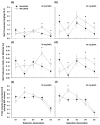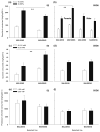Selective breeding for magnitude of methamphetamine-induced sensitization alters methamphetamine consumption
- PMID: 21088960
- PMCID: PMC3320759
- DOI: 10.1007/s00213-010-2086-2
Selective breeding for magnitude of methamphetamine-induced sensitization alters methamphetamine consumption
Abstract
Rationale: Genetically determined differences in susceptibility to drug-induced sensitization could be related to risk for drug consumption.
Objectives: Studies were performed to determine whether selective breeding could be used to create lines of mice with different magnitudes of locomotor sensitization to methamphetamine (MA). MA sensitization (MASENS) lines were also examined for genetically correlated responses to MA.
Methods: Beginning with the F2 cross of C57BL/6J and DBA/2J strains, mice were tested for locomotor sensitization to repeated injections of 1 mg/kg MA and bred based on magnitude of sensitization. Five selected offspring generations were tested. All generations were also tested for MA consumption, and some were tested for dose-dependent locomotor-stimulant responses to MA, consumption of saccharin, quinine, and potassium chloride as a measure of taste sensitivity, and MA clearance after acute and repeated MA.
Results: Selective breeding resulted in creation of two lines [MA high sensitization (MAHSENS) and MA low sensitization (MALSENS)] that differed in magnitude of MA-induced sensitization. Initially, greater MA consumption in MAHSENS mice reversed over the course of selection so that MALSENS mice consumed more MA. MAHSENS mice exhibited greater sensitivity to the acute stimulant effects of MA, but there were no significant differences between the lines in MA clearance from blood.
Conclusions: Genetic factors influence magnitude of MA-induced locomotor sensitization and some of the genes involved in magnitude of this response also influence MA sensitivity and consumption. Genetic factors leading to greater MA-induced sensitization may serve a protective role against high levels of MA consumption.
Conflict of interest statement
Figures






Similar articles
-
Behavioral inhibition in mice bred for high vs. low levels of methamphetamine consumption or sensitization.Psychopharmacology (Berl). 2012 Jul;222(2):353-65. doi: 10.1007/s00213-012-2650-z. Epub 2012 Feb 4. Psychopharmacology (Berl). 2012. PMID: 22311384 Free PMC article.
-
Sensitivity to psychostimulants in mice bred for high and low stimulation to methamphetamine.Genes Brain Behav. 2005 Mar;4(2):110-25. doi: 10.1111/j.1601-183X.2004.00101.x. Genes Brain Behav. 2005. PMID: 15720407
-
Opioid sensitivity in mice selectively bred to consume or not consume methamphetamine.Addict Biol. 2014 May;19(3):370-9. doi: 10.1111/adb.12003. Epub 2012 Nov 12. Addict Biol. 2014. PMID: 23145527 Free PMC article.
-
Drug sensitization induced by prenatal methamphetamine exposure.Cesk Fysiol. 2016 Oct;65(1):32-37. Cesk Fysiol. 2016. PMID: 29489090 Review. Czech, English.
-
Behavioral genetic contributions to the study of addiction-related amphetamine effects.Neurosci Biobehav Rev. 2008;32(4):707-59. doi: 10.1016/j.neubiorev.2007.10.008. Epub 2007 Nov 29. Neurosci Biobehav Rev. 2008. PMID: 18207241 Free PMC article. Review.
Cited by
-
CNTN1 in the Nucleus Accumbens is Involved in Methamphetamine-Induced Conditioned Place Preference in Mice.Neurotox Res. 2023 Aug;41(4):324-337. doi: 10.1007/s12640-023-00640-9. Epub 2023 Apr 4. Neurotox Res. 2023. PMID: 37014368
-
Methamphetamine-induced conditioned place preference in LG/J and SM/J mouse strains and an F45/F46 advanced intercross line.Front Genet. 2012 Jul 11;3:126. doi: 10.3389/fgene.2012.00126. eCollection 2012. Front Genet. 2012. PMID: 22798962 Free PMC article.
-
An animal model of differential genetic risk for methamphetamine intake.Front Neurosci. 2015 Sep 23;9:327. doi: 10.3389/fnins.2015.00327. eCollection 2015. Front Neurosci. 2015. PMID: 26441502 Free PMC article. Review.
-
Genetic factors involved in risk for methamphetamine intake and sensitization.Mamm Genome. 2013 Dec;24(11-12):446-58. doi: 10.1007/s00335-013-9484-9. Epub 2013 Nov 13. Mamm Genome. 2013. PMID: 24217691 Free PMC article.
-
Nine generations of selection for high and low nicotine intake in outbred Sprague-Dawley rats.Behav Genet. 2013 Sep;43(5):436-44. doi: 10.1007/s10519-013-9605-y. Epub 2013 Aug 4. Behav Genet. 2013. PMID: 23912820 Free PMC article.
References
-
- Atkins AL, Helms ML, O’Toole LA, Belknap JK. Stereotypic behaviors in mice selectively bred for high and low methamphetamine-induced stereotypic chewing. Psychopharmacology (Berl) 2001;157:96–104. - PubMed
-
- Belknap JK, Richards SP, O’Toole LA, Helms ML, Phillips TJ. Short-term selective breeding as a tool for QTL mapping: ethanol preference drinking in mice. Behav Genet. 1997;27:55–66. - PubMed
-
- Boileau I, Dagher A, Leyton M, Gunn RN, Baker GB, Diksic M, Benkelfat C. Modeling sensitization to stimulants in humans: an [11C]raclopride/positron emission tomography study in healthy men. Arch Gen Psychiatry. 2006;63:1386–1395. - PubMed
Publication types
MeSH terms
Substances
Grants and funding
LinkOut - more resources
Full Text Sources
Medical
Miscellaneous

